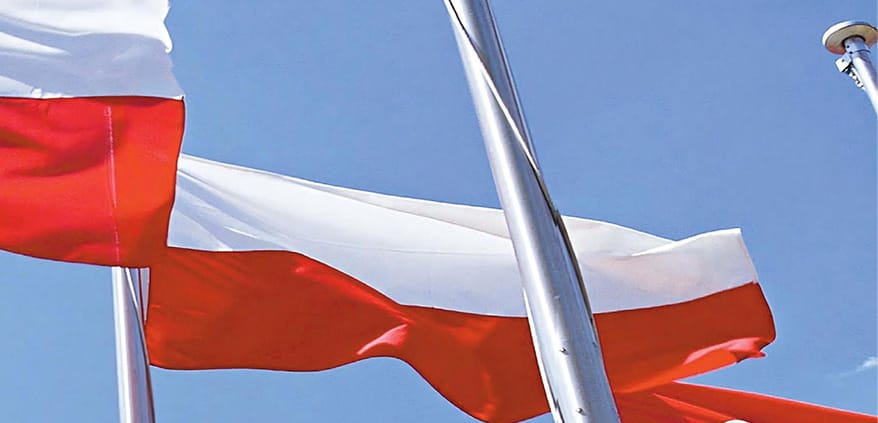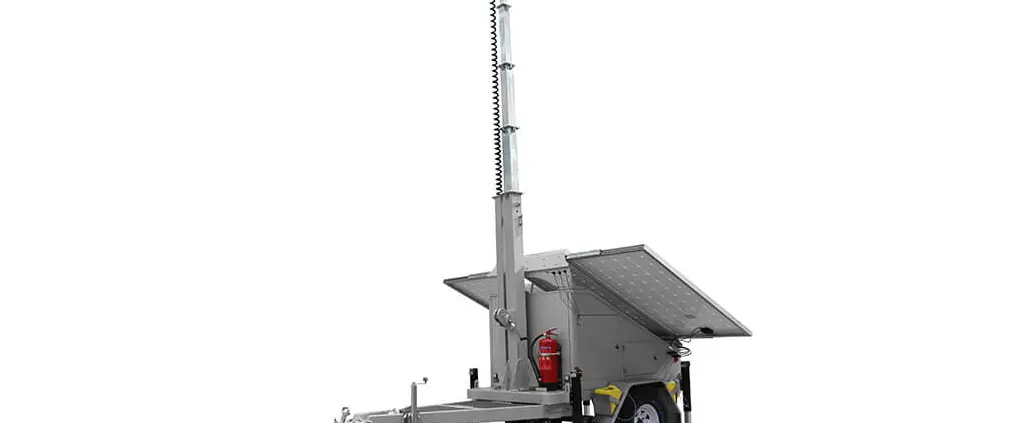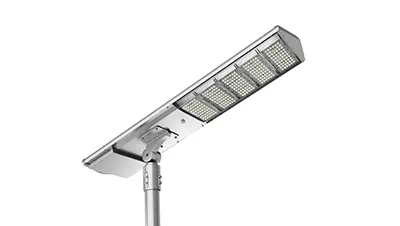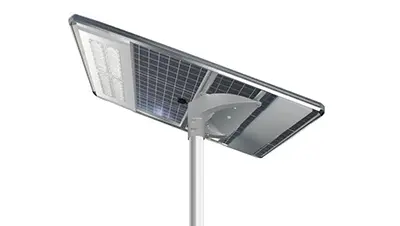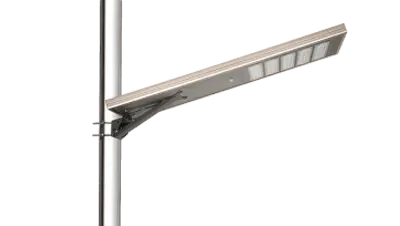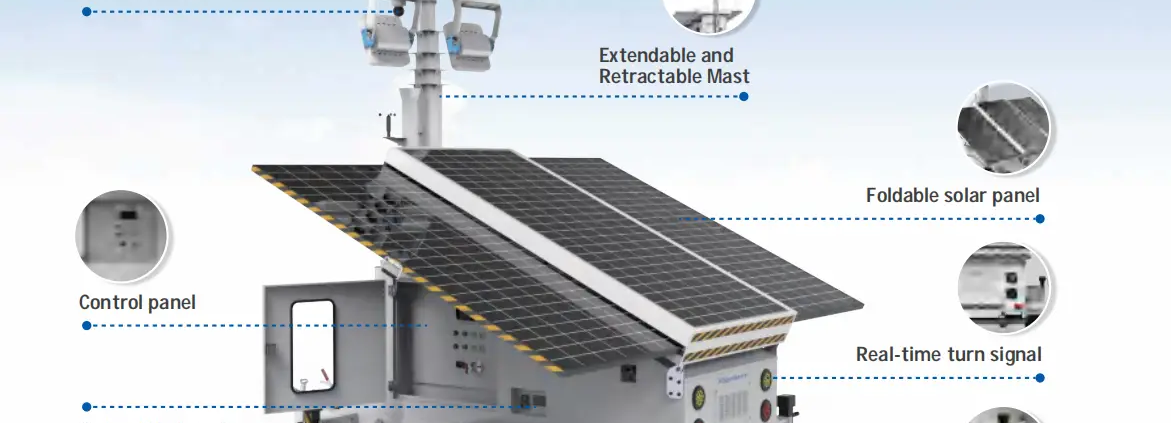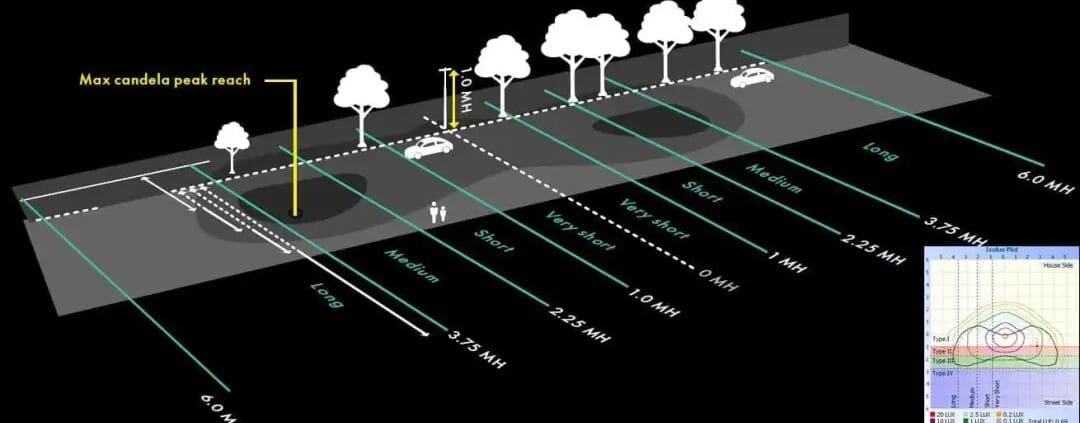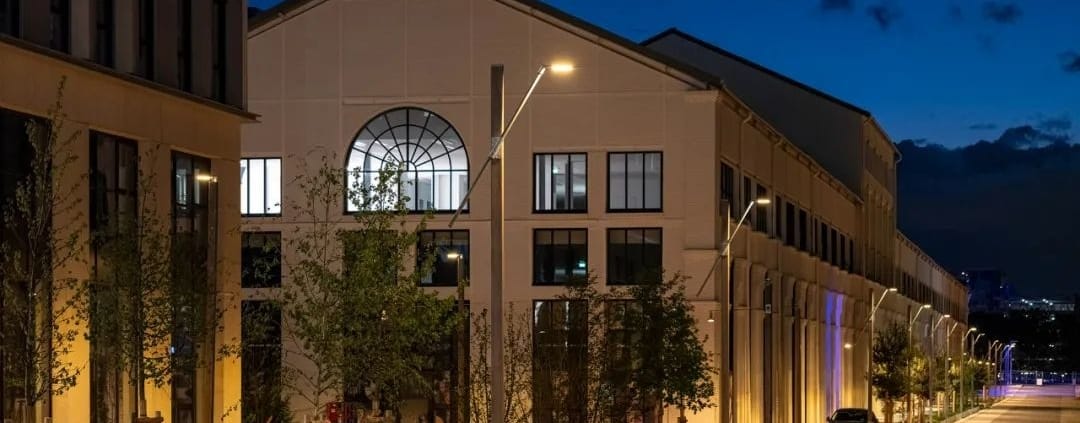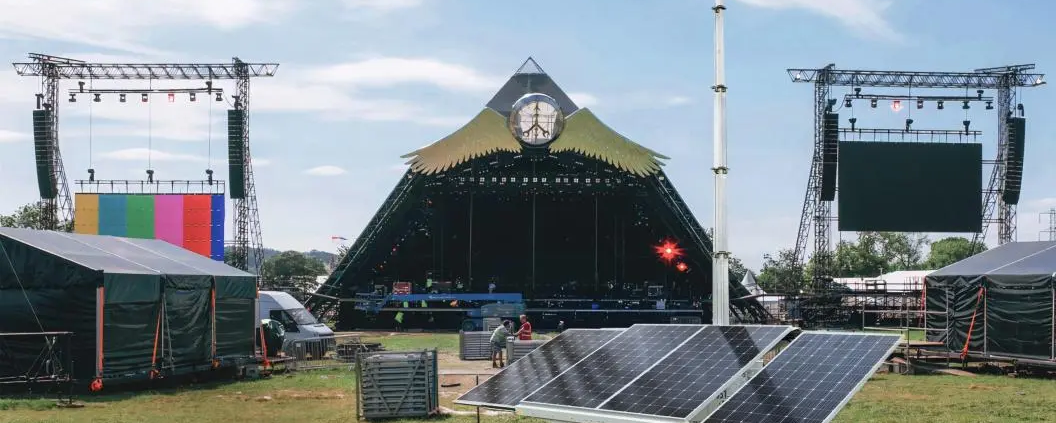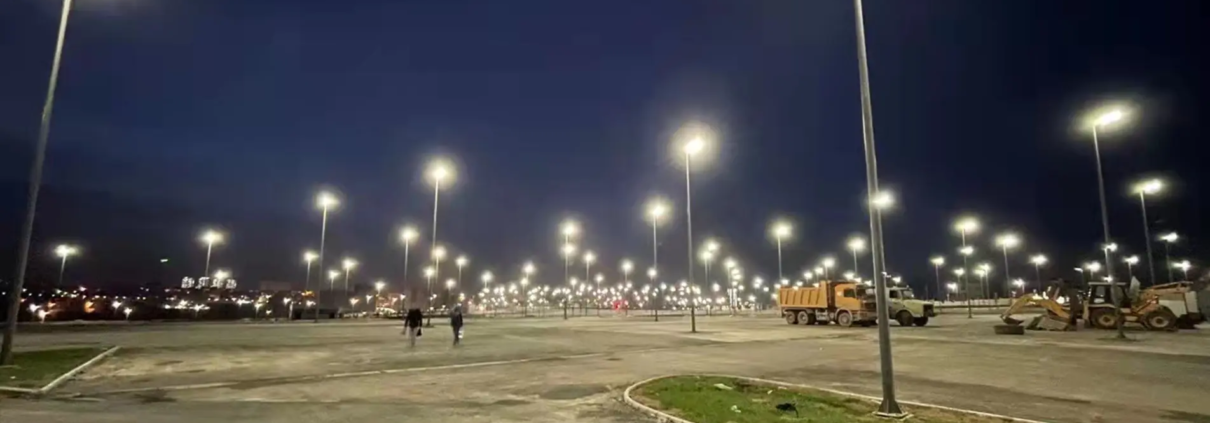Solution de lampadaire solaire Sadui et meilleur type de produit
1. Conformité aux normes
- Cette proposition respecte scrupuleusement la norme saoudienne SASO 2927:2019 (Efficacité énergétique et exigences fonctionnelles de l'éclairage routier). Cette norme impose aux lampadaires LED de passer un enregistrement d'efficacité énergétique (certification EER), garantissant ainsi leur conformité aux normes saoudiennes en matière de durée de vie, de maintien du flux lumineux, de cycles de commutation, etc. L'importation de produits non certifiés est interdite.
2. Sélection de la luminosité
- Éclairement (Lux)Selon les normes saoudiennes d'éclairage routier (référencées CEN/TR 13201-1), l'éclairement moyen des routes principales doit être ≥ 20 Lux, avec une uniformité (rapport éclairement minimum/moyen) ≥ 0,4 ; pour les routes secondaires, il doit être ≥ 10 Lux, avec une uniformité ≥ 0,35. La proposition recommande un éclairement de 20 à 30 Lux pour les routes principales, avec une uniformité < 1,5 (obtenue grâce à l'optimisation de la conception optique).
- Flux lumineux (lumens)Selon la largeur et la hauteur de la route, le flux lumineux recommandé pour la source lumineuse est compris entre 10 000 et 20 000 lumens. Par exemple, des lampadaires de 8 à 10 mètres nécessitent un flux lumineux de 12 000 à 15 000 lumens.
- Efficacité lumineuse (lm/W):Les sources lumineuses LED doivent avoir une efficacité ≥ 130 lm/W pour garantir des économies d'énergie (comme l'exige la norme SASO 2927).
- Uniformité:L'uniformité de l'éclairement (Uo) doit être ≤ 1,5, obtenue grâce à la conception de la lentille ou du réflecteur pour éviter les zones sombres et l'éblouissement.

3. Sélection de la température de couleur
- La température de couleur recommandée est de 4 000 K à 6 000 K. Cette plage offre une grande clarté visuelle, réduit la fatigue et répond aux exigences environnementales élevées de l'Arabie saoudite (des températures de couleur élevées améliorent la vigilance). Évitez les températures inférieures à 3 000 K (trop chaudes).
4. Conception et matériaux de hauteur
- Hauteur du mât de la lampe:En fonction du type de route :
- Routes principales : 10 à 12 mètres (couvrant 4 à 6 voies).
- Routes secondaires ou rues locales : 6–8 mètres.
- Matériau du mât de lampeFabriqué en acier galvanisé à chaud (traité anticorrosion) ou en alliage d'aluminium (léger), résistant au vent ≥ 150 km/h, adapté au climat désertique saoudien. La conception de la base doit être conforme aux normes de résistance au vent (par exemple, EN 40-5).
5. Indice de rendu des couleurs (IRC)
- IRC ≥ 80 (exigence minimale de la norme SASO 2927), IRC ≥ 90 recommandé pour garantir une reproduction fidèle des couleurs (particulièrement adapté aux paysages urbains). Un IRC élevé réduit les erreurs visuelles et améliore la sécurité.

6. Configuration de la conception du système d'éclairage public
- Journées d'éclairage continu:Autonomie prévue pour 5 jours de pluie consécutifs. L'Arabie saoudite dispose d'abondantes ressources solaires (rayonnement annuel moyen de 2 200 à 2 500 kWh/m²), mais compte tenu de l'impact des tempêtes de poussière, la capacité de la batterie devrait être redondante.
- Configuration de la batterie : batterie au lithium fer phosphate (LiFePO4), systèmes 12,8 V ou 25,6 V, avec une durée de vie de > 5 000 fois.
- Panneau solaire : Panneau solaire monocristallin à haut rendement, efficacité de conversion ≥21%, associé à un contrôleur MPPT pour améliorer l'efficacité de charge.
- Exemple de configuration système (pour les routes principales) :
- Source lumineuse LED : 100W (flux lumineux 14 000 lumens).
- Panneau solaire : 18V/300W (monocristallin).
- Batterie : 12,8 V/100 Ah (Lithium Fer Phosphate).
- Contrôleur : type MPPT, avec capacité de gradation intelligente.
7. Optimisation du système : contrôle automatique de l'éclairage
- Fonctionnalités de contrôle intelligentes
- Contrôle de la lumière + Contrôle du temps: Allume et éteint automatiquement les lumières en fonction de la lumière ambiante (s'allume au crépuscule, s'éteint à l'aube).
- Gradation adaptative:Réduit automatiquement la puissance de 50% en cas de faible trafic après minuit (conformément aux exigences d'économie d'énergie SASO).
- Capteurs de mouvement:Équipé en option de capteurs humains pour augmenter la luminosité à l'approche de personnes ou de véhicules.
- Surveillance à distance:Permet le diagnostic des pannes et la gestion de la consommation énergétique via la plateforme IoT (comme la 4G/5G).
8. Sadui Meilleur lampadaire solaire Recommandations de Luxman Light
Basé sur les produits Luxman https://luxmanlight.com/led-solar-street-light-outdoor, nous recommandons les séries de produits suivantes (produits conformes à la certification SASO 2927), toutes répondant aux conditions d'éclairage et aux indicateurs ci-dessus.
LAMPADAIRE SOLAIRE TOUT-EN-UN – MA SÉRIE
- Conception intégrée
- Autonomie maximale 5 à 7 jours de pluie
- Télécommande
- Température de couleur : personnalisable
- Efficacité lumineuse LED : ≥ 130 lm/W
- Panneau solaire : efficacité de conversion ≥ 21%
LAMPADAIRE SOLAIRE À HAUTE LUMEN – SÉRIE HS
- 15 000 lm à 20 000 lm
- Autonomie maximale 2-3 jours de pluie
- IP66 étanche
- Température de couleur : personnalisable
- Efficacité lumineuse LED : ≥ 130 lm/W
- Panneau solaire : efficacité de conversion ≥ 21%
Lampadaire solaire à LED pour extérieur – Série S2
- Capteurs du crépuscule à l'aube
- Autonomie maximale 5 à 7 jours de pluie
- Mode de détection PIR
- Température de couleur : personnalisable
- Efficacité lumineuse LED : ≥ 130 lm/W
- Panneau solaire : efficacité de conversion ≥ 21%
Résumé
Cette proposition est conforme à la norme saoudienne SASO 2927 et nous recommandons l'utilisation de la gamme de produits Luxman SolarStar, qui offre une efficacité lumineuse élevée, un contrôle intelligent et une durabilité adaptée à l'environnement saoudien. Lors de la mise en œuvre, il est conseillé de privilégier les projets pilotes sur les routes principales et d'effectuer un entretien régulier (comme le nettoyage des panneaux solaires) afin d'optimiser le retour sur investissement. Pour toute personnalisation, veuillez contacter Luxman afin d'obtenir des informations sur la certification SASO et le support technique.
Quels sont les types de modèles de distribution de lumière des lampadaires IESNA et leurs applications ?
La distribution lumineuse des luminaires LED désigne la distribution, la direction et l'intensité de la lumière émise par les luminaires. Elle a un impact significatif sur l'efficacité lumineuse, l'efficacité énergétique et le confort visuel. Une distribution lumineuse adéquate permet d'obtenir un éclairement et une uniformité appropriés, d'économiser de l'énergie, de réduire l'éblouissement, d'améliorer la sécurité, de diminuer la pollution lumineuse et de créer un environnement lumineux confortable. Les entreprises d'éclairage LED doivent concevoir des distributions lumineuses adaptées pour exploiter pleinement les avantages de leurs luminaires, tandis que les ingénieurs et concepteurs lumière doivent sélectionner des schémas de distribution adaptés à leurs besoins spécifiques afin d'optimiser les effets lumineux des luminaires LED.
Lorsqu'une source lumineuse émet de la lumière, sa direction de propagation peut ne pas correspondre à la direction attendue. Dans ce cas, des structures spécifiques (telles que des lentilles et des réflecteurs) doivent être conçues pour modifier la direction de propagation de la lumière. Cela implique d'ajuster la distribution spatiale de la lumière pour obtenir l'effet souhaité. Cette méthode de contrôle de la direction de propagation de la lumière est appelée courbe photométrique du luminaire ou distribution lumineuse.
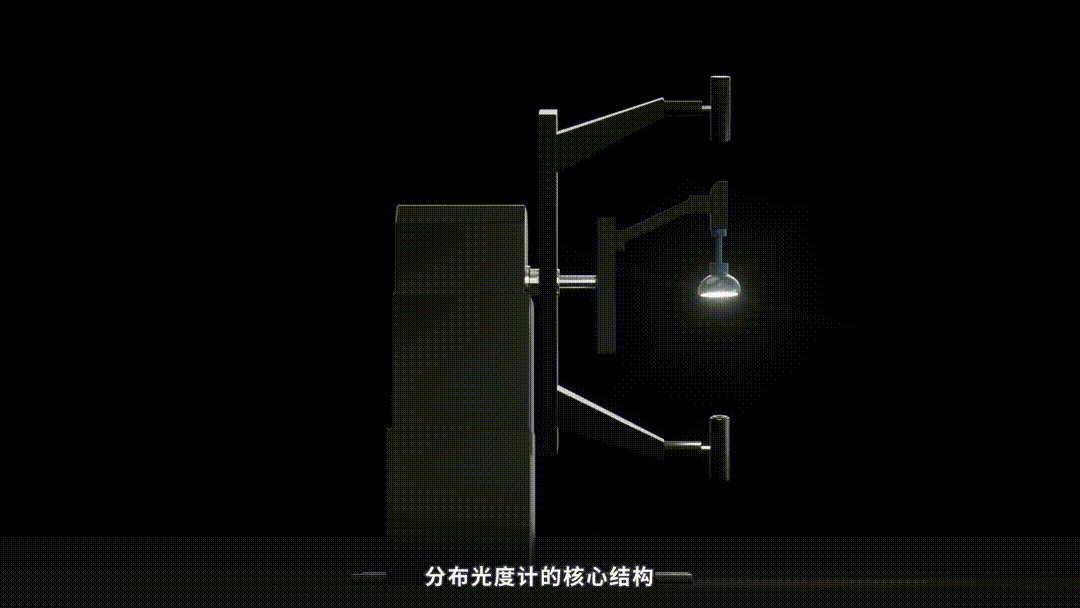
La courbe de distribution d'intensité lumineuse, communément appelée courbe photométrique ou courbe de distribution lumineuse (LDC), illustre la distribution spatiale de l'intensité lumineuse du luminaire. Elle est obtenue directement par des mesures du luminaire à l'aide d'un photomètre. Les formats courants pour les courbes de distribution d'intensité sont IES (Amérique du Nord) et LDT (Europe). En tant qu'acheteurs, nous pouvons également obtenir ces fichiers en contactant les fabricants de luminaires. Il existe deux méthodes pour représenter les courbes photométriques : pour les projecteurs, on utilise généralement un système de coordonnées rectangulaires, tandis que pour l'éclairage intérieur et routier, on adopte des coordonnées polaires.
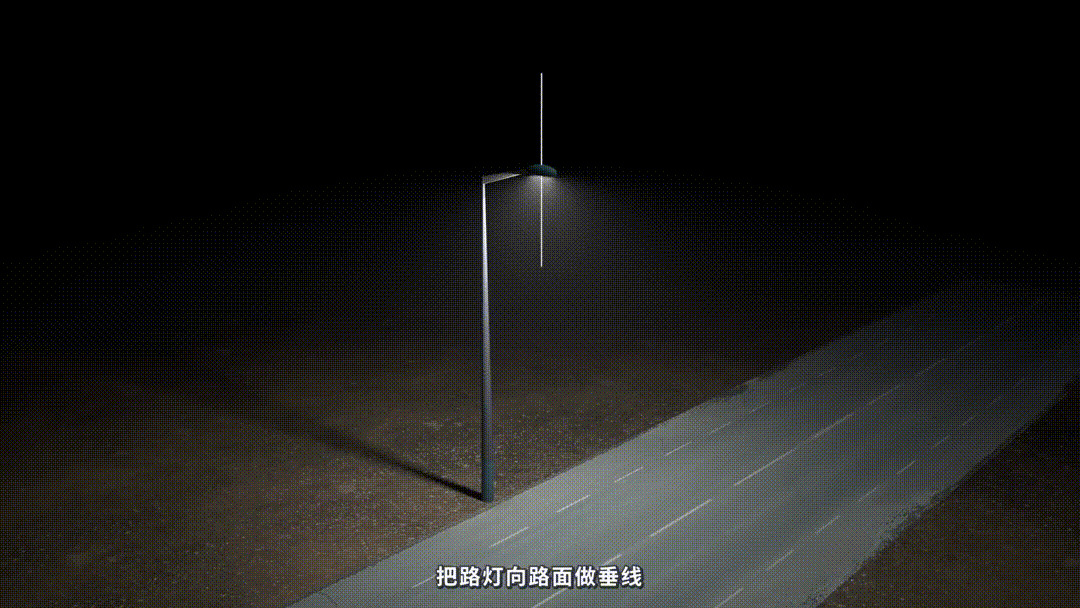
Courbe de distribution de la lumière (coordonnées polaires)
Dans un plan de mesure passant par le centre de la source lumineuse, les valeurs d'intensité lumineuse du luminaire sont mesurées sous différents angles. À partir d'une certaine direction, l'intensité lumineuse à chaque angle est indiquée et représentée par des vecteurs. La connexion des extrémités de ces vecteurs forme la courbe de distribution de la lumière polaire (courbe photométrique) du luminaire, comme illustré à gauche de l'image suivante.
Courbe de distribution de la lumière (coordonnées linéaires)
Cette courbe de distribution est généralement utilisée pour des appareils tels que les projecteurs et les projecteurs à LED. Comme les faisceaux de ces luminaires sont concentrés dans un angle solide très faible, il est difficile de représenter leur distribution spatiale d'intensité lumineuse à l'aide de coordonnées polaires. C'est pourquoi certains fabricants utilisent des courbes de distribution lumineuse à coordonnées linéaires ou des courbes photométriques pour représenter leur distribution lumineuse. L'axe vertical représente l'intensité lumineuse (I), tandis que l'axe horizontal représente l'angle du faisceau, comme illustré à droite de l'image suivante.
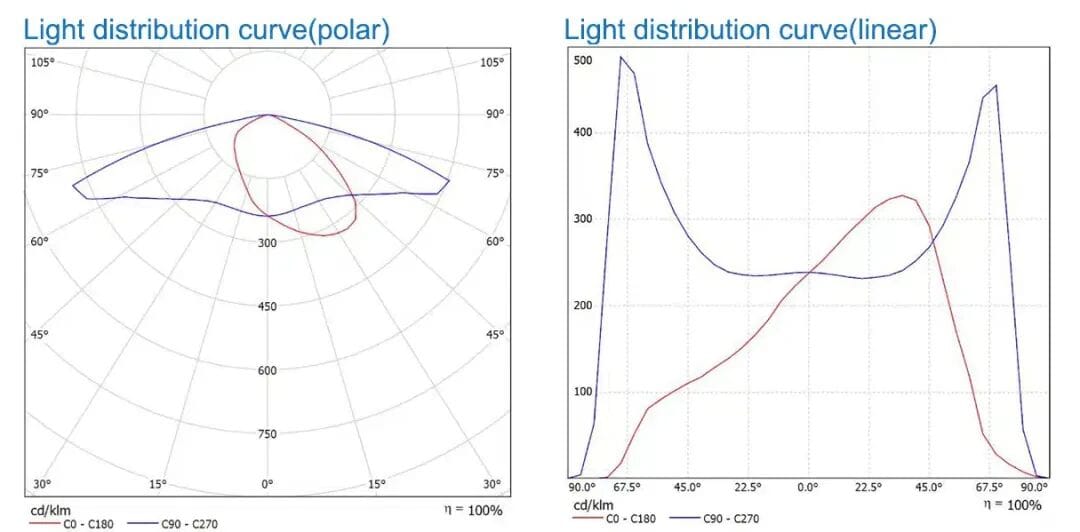
Classification des types de distribution d'éclairage IESNA
Depuis sa création en 1906, l'Illuminating Engineering Society of North America (IESNA) a plus d'un siècle d'histoire. La classification des distributions lumineuses introduite par l'IESNA est encore largement utilisée aujourd'hui. Le système de classification de la distribution des luminaires est clairement défini dans la norme ANSI/IESNA RP-8-1983. Les types de luminaires définis par l'Illuminating Engineering Society of North America sont des catégories normalisées utilisées pour décrire les schémas de distribution lumineuse des luminaires. Ces types de distribution aident les professionnels et les concepteurs d'éclairage à comprendre comment les luminaires produisent et se propagent la lumière dans une zone donnée. L'IES définit plusieurs types de distribution standard, chacun représenté par un code à deux lettres. Les types de distribution de luminaires courants de l'IES sont les types I, II, III, IV et V, suivis de chiffres romains (IV), où S, M et L représentent respectivement les valeurs courtes, moyennes et longues. La classification spécifique est déterminée par les points d'intensité maximale et 50% du fichier IES, qui seront détaillés dans les sections suivantes.
Il existe actuellement de nombreux formats normalisés pour les fichiers photométriques, parmi lesquels EULUMDAT, CIE102 et IESNA LM-63. IESNA LM-63 est utilisé en Amérique du Nord, EULUMDAT en Europe, et CIE102 en Nouvelle-Zélande. La norme actuelle, datant de 2002, a été approuvée et reconnue par l'American National Standards Institute (ANSI). IESNA LM-63-2002 est devenu le format de fichier photométrique dédié à l'Amérique du Nord, avec l'extension « *.ies ».
Les types de distribution d'éclairage IESNA définissent plus précisément la répartition lumineuse des luminaires en fonction de la forme de la zone éclairée. Pour la distribution latérale, ce modèle décrit la diffusion de la lumière par le luminaire et est caractérisé par le point où l'intensité atteint 50%. Ce modèle de distribution implique la capacité du luminaire à projeter la lumière vers l'avant et vers l'arrière. En termes simples, pour éclairer une seule voie, le type I peut convenir ; pour éclairer deux voies, le type II peut être plus approprié. Cependant, cette règle n'est pas stricte et dépend de facteurs tels que la hauteur de montage, l'angle d'inclinaison, la longueur du bras et la distance du luminaire par rapport au bord de la route. L'IESNA a défini cinq principaux modèles de distribution lumineuse : Type I, Type II, Type III, Type IV et Type V. Ces classifications sont couramment utilisées pour déterminer les spectres adaptés aux routes de différentes largeurs.

Dans les normes publiées par l'IESNA, la route est divisée longitudinalement en cinq zones, comme illustré ci-dessus. La distribution lumineuse latérale est classée selon la zone où se situe le point d'intensité maximale 50%. Pour les courbes de distribution lumineuse des luminaires ci-dessus, si le point d'intensité 50% se situe dans la zone de Type III, le type de distribution lumineuse correspondant est classé comme Type III. Le schéma montre que cette distribution convient aux routes à trois voies. Différentes distributions lumineuses latérales conviennent à différents scénarios d'application, comme détaillé ci-dessous :
- Type I : 1-1 MH. Lorsque la trajectoire d'intensité lumineuse du 50% se situe entre 1 MH côté luminaire et côté rue, on parle de distribution lumineuse étroite symétrique ou asymétrique de type I. Convient aux trottoirs, chemins et routes à voie unique.
- Type II : 1-1,75 MH. Lorsque la trajectoire d'intensité lumineuse du 50% se situe entre 1 MH et 1,75 MH côté rue, on parle de distribution lumineuse asymétrique étroite de type II. Convient aux routes à une ou deux voies, aux routes principales et aux autoroutes.
- Type III : 1,75-2,75 MH. Lorsque la trajectoire d'intensité lumineuse du 50% se situe entre 1,75 MH et 2,75 MH côté rue, on parle de distribution lumineuse asymétrique large de type III. Convient aux routes principales, aux autoroutes et aux parkings.
- Type IV : 2,75-3,75 MH. Lorsque la trajectoire d'intensité lumineuse du 50% se situe entre 2,75 MH et 3,75 MH côté rue, on parle de distribution lumineuse asymétrique large de type IV. Convient aux parkings, places et éclairages muraux.
- Type V : Motif circulaire symétrique, avec une distribution lumineuse symétrique autour du luminaire, assurant une diffusion lumineuse uniforme à l'avant comme à l'arrière. Convient pour l'éclairage de parkings et de zones.
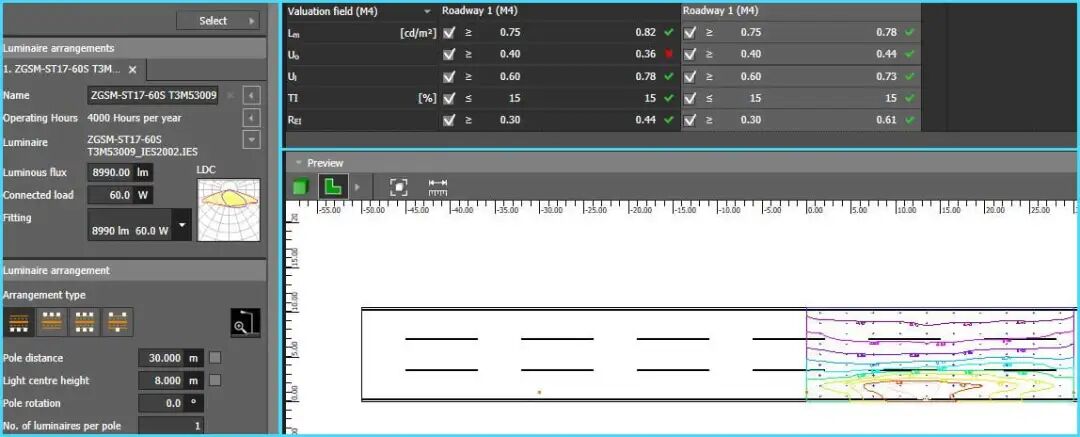
Distribution lumineuse verticale et longitudinale
La distribution lumineuse verticale désigne la distribution lumineuse verticale d'un luminaire, basée sur la position de l'intensité lumineuse maximale (mesurée en candelas) sur la grille parallèle au TRL. La route longeant le TRL est divisée en différentes zones selon leur distance par rapport au TRL (exprimée en multiples de la hauteur d'installation). La distribution lumineuse longitudinale implique la capacité du luminaire à projeter la lumière vers la gauche et la droite, définie par son point d'intensité maximale. Selon la définition de l'IESNA, la catégorie « S » s'applique aux espacements entre poteaux inférieurs à 2,25 fois la hauteur de montage, la catégorie « M » aux espacements entre poteaux compris entre 2,25 et 3,75 fois, et la catégorie « L » aux espacements entre poteaux compris entre 3,75 et 6 fois. Cependant, cette règle n'est pas stricte et dépend de facteurs tels que la disposition des luminaires et l'état de la route. En général, les luminaires classés « S » conviennent aux espacements entre poteaux plus petits, tandis que les luminaires classés « L » conviennent aux espacements plus importants.
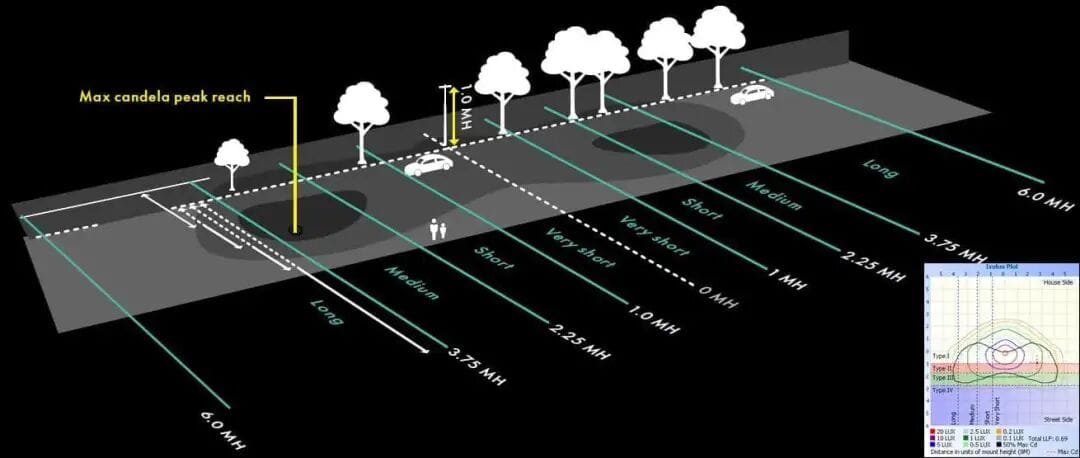
Dans les normes publiées par l'IESNA, la route est divisée transversalement en trois zones, comme illustré ci-dessus. La distribution lumineuse longitudinale est classée selon la zone où se situe le point d'intensité maximale 100%. Pour les courbes de distribution lumineuse des luminaires présentés, si le point d'intensité maximale du lampadaire se situe dans la zone « moyenne », le type de distribution lumineuse correspondant est classé « Type II Moyen ». Le schéma montre que ce modèle de distribution lumineuse présente un espacement des poteaux d'environ 3,0 à 3,5 fois la hauteur du poteau. Différentes distributions lumineuses longitudinales conviennent à différents scénarios d'espacement des poteaux, comme indiqué ci-dessous :
- CONTRE, 0-1,0 MH : Lorsque la trajectoire d'intensité lumineuse 100% est située entre 0 et 1,0 MH dans les lignes transversales de la route, on parle de distribution lumineuse longitudinale VS (très courte).
- S, 1,0-2,25 MH : Lorsque la trajectoire d'intensité lumineuse 100% est située entre 1,0 et 2,25 MH dans les lignes transversales de la route, on parle de distribution lumineuse longitudinale S (courte).
- M., 2,25-3,75 MH : Lorsque la trajectoire d'intensité lumineuse 100% est située entre 2,25 et 3,75 MH dans les lignes transversales de la route, on parle de distribution lumineuse longitudinale M (moyenne).
- L, 3,75-6,0 MH : Lorsque la trajectoire d'intensité lumineuse du 100% est située entre 3,75 et 6,0 MH dans les lignes transversales de la route, on parle de distribution lumineuse longitudinale L (Long).
- VL, >6,0 MH : Lorsque la trajectoire d'intensité lumineuse 100% est située au-delà de 6,0 MH dans les lignes transversales de la route, on parle de distribution lumineuse longitudinale VL (très longue).
Caractéristiques d'application de la distribution lumineuse longitudinale
Nous avons utilisé DIALux evo pour analyser les applications des lampadaires de type II S et de type II M.
Les conditions de la route sont les suivantes : largeur de 7 mètres, trois voies, surplomb de 0,8 mètre, hauteur de poteau de 8 mètres, espacement des luminaires de 36 mètres, conformément au niveau d'éclairage EN13201 M4.
Après avoir importé les données photométriques des types II S et II M dans DIALux evo pour analyse, les résultats sont très clairs. Pour le type II S, la distribution lumineuse longitudinale est relativement courte et ne parvient pas à répartir efficacement la lumière sur les côtés des luminaires. Par conséquent, l'espacement entre les deux luminaires doit être réduit à 33 mètres afin de garantir un éclairage adéquat au milieu. Cet ajustement est nécessaire pour obtenir l'uniformité requise. En revanche, la distribution de type II M est plus performante avec un espacement de 36 mètres, et tous les paramètres de simulation sont conformes à la norme M4. Cet espacement de 36 mètres représente 4,5 fois la hauteur de montage, dépassant légèrement la valeur de 3,75 recommandée par l'IESNA. Il est donc conseillé de se baser sur les résultats de la simulation d'éclairage pour le choix final des luminaires.

Ce qui précède présente principalement le concept de distribution lumineuse IESNA, couvrant les distributions de type I, II et III, ainsi que les concepts de distribution lumineuse courte, moyenne et longue, et décrit brièvement leurs applications pratiques. La compréhension de ces concepts permet de déterminer rapidement le type photométrique approprié à un projet. Par exemple, la distribution de type II convient aux routes à une ou deux voies, tandis que la distribution courte est adaptée aux scénarios où l'espacement des poteaux est trois fois supérieur à la hauteur de montage. La distribution moyenne convient à des espacements des poteaux de quatre à cinq fois la hauteur de montage. Bien entendu, ces valeurs ne sont pas absolues et la validation doit être effectuée avec DIALux ou un autre logiciel de simulation d'éclairage routier.
La logique sous-jacente de l'éclairage routier urbain : comprendre comment, pourquoi et où la lumière est projetée
1. Introduction
La conception de l'éclairage extérieur est une discipline complexe qui dépasse le simple éclairage spatial ; elle influence profondément la sécurité publique, le confort visuel, la consommation d'énergie et l'environnement naturel. Un contrôle et une distribution précis de la lumière sont essentiels pour atteindre ces objectifs multidimensionnels. Cet article propose une analyse complète des principaux concepts de distribution lumineuse, notamment les luminaires à coupure (coupure totale, coupure et semi-coupure), les luminaires sans coupure et les distributions en aile de chauve-souris, tout en les comparant rigoureusement aux normes établies pour l'éclairage public en Amérique du Nord (principalement définies par l'Illuminating Engineering Society of North America (IESNA)). En décortiquant les définitions techniques, les caractéristiques et les applications typiques de chaque type, cet article clarifiera les distinctions et les synergies entre eux, offrant ainsi des informations précieuses aux professionnels de l'urbanisme, du génie civil et de la conception d'éclairage pour développer des solutions d'éclairage extérieur durables, conformes et de haute qualité.
2. Comprendre la classification des seuils de coupure des appareils
La classification de coupure des luminaires définit la quantité de lumière émise au-dessus du plan horizontal, jouant un rôle crucial dans la gestion de la pollution lumineuse, de l'éblouissement et de la pénétration de lumière. Ces classifications, historiquement définies par l'Illuminating Engineering Society (IES), fournissent un cadre pour contrôler les émissions lumineuses vers le haut.
2.1. Appareils à coupure complète
La distribution lumineuse des luminaires à coupure totale est définie par deux normes strictes : premièrement, l'intensité lumineuse (candelas) au nadir (directement en dessous) à 90 degrés ou plus est nulle, ce qui indique que le luminaire n'émet aucune lumière directement vers le haut 1Deuxièmement, la valeur de candela à un angle vertical de 80 degrés ou plus pour 1000 lumens de lampe nue ne dépasse pas 100 (c'est-à-dire 10%) 1Ces limites s'appliquent à tous les angles latéraux autour du luminaire.
Les luminaires à coupure totale sont conçus pour diriger toute la lumière vers le bas, minimisant ainsi efficacement la lueur du ciel (l'éclaircissement du ciel nocturne) et l'intrusion de lumière (la lumière indésirable se répandant sur les propriétés adjacentes) 5Cette caractéristique les rend indispensables pour respecter la réglementation sur le ciel étoilé et préserver les environnements nocturnes. De plus, en contrôlant rigoureusement la lumière à fort angle, ils réduisent considérablement l'éblouissement direct, améliorant ainsi le confort visuel et la sécurité des conducteurs et des piétons. 6Leur efficacité à diriger précisément la lumière uniquement là où l'éclairage est nécessaire contribue également à la conservation de l'énergie. 6. Ainsi, de nombreuses réglementations locales et normes environnementales en Amérique du Nord imposent ou recommandent fortement l'utilisation de luminaires à coupure totale 5.
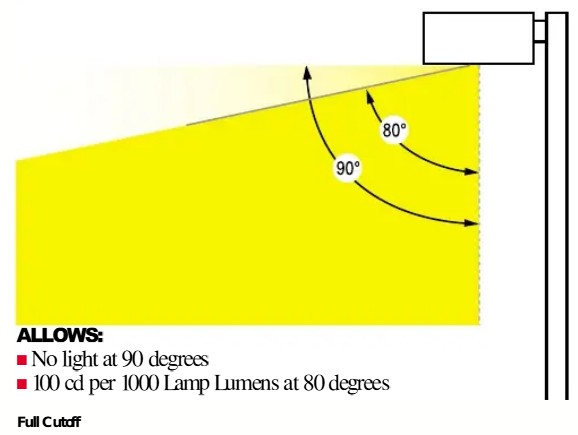
2.2. Appareils de coupure
La distribution lumineuse des luminaires à coupure est définie par des limites de candela spécifiques : la valeur de candela à un angle vertical de 90 degrés ne dépasse pas 25 (2,5%) 2Au nadir, la valeur de candela à un angle vertical de 80 degrés ne dépasse pas 100 (10%) 2Ces limites s'appliquent à tous les angles latéraux. Bien qu'une faible quantité de lumière soit autorisée au-dessus de 90 degrés, les luminaires à coupure permettent néanmoins de contrôler significativement la lumière vers le haut par rapport aux luminaires à coupure semi-automatique ou sans coupure, contribuant ainsi à réduire la pollution lumineuse.
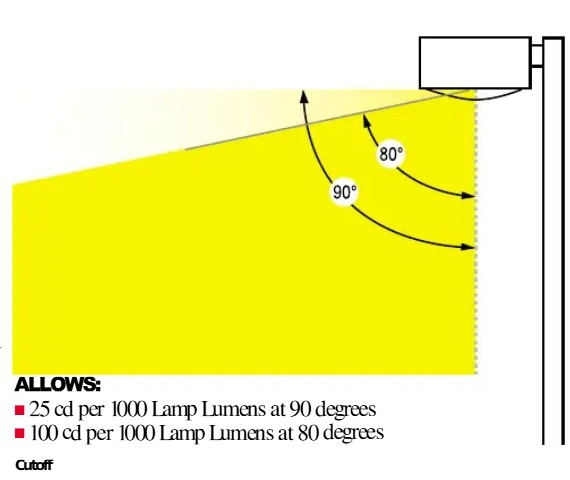
2.3. Appareils semi-cutoff
Les luminaires semi-coupés ont des restrictions plus souples sur la lumière vers le haut : la valeur de candela à un angle vertical de 90 degrés ne dépasse pas 50 (5%) 2À 80 degrés, la valeur de candela ne dépasse pas 200 (20%) 2Ces limites s'appliquent à tous les angles latéraux. Comparés aux luminaires à coupure totale ou partielle, les luminaires à coupure partielle émettent davantage de lumière à des angles élevés, augmentant ainsi le risque d'éblouissement et de halo lumineux. Ils ne sont généralement pas recommandés pour les zones écologiquement sensibles ou les situations nécessitant un contrôle strict de la pollution lumineuse.
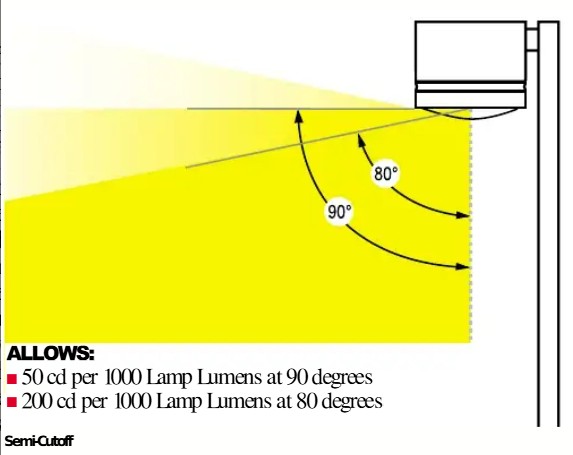
2.4. Appareils sans coupure
Les luminaires sans coupure se caractérisent par l'absence de restrictions d'intensité lumineuse (candelas) au-dessus de leur région de candelas maximale 2Ces luminaires émettent de la lumière dans toutes les directions, y compris une quantité importante de lumière vers le haut et à l'horizontale. Ce manque de contrôle entraîne une pollution lumineuse importante (luminosité du ciel), une intrusion lumineuse importante dans les propriétés adjacentes et produit souvent un éblouissement désagréable. 9En raison des préoccupations environnementales croissantes et des efforts réglementaires visant à contrôler la pollution lumineuse, leur utilisation est de plus en plus restreinte ou interdite dans de nombreuses juridictions. 6.
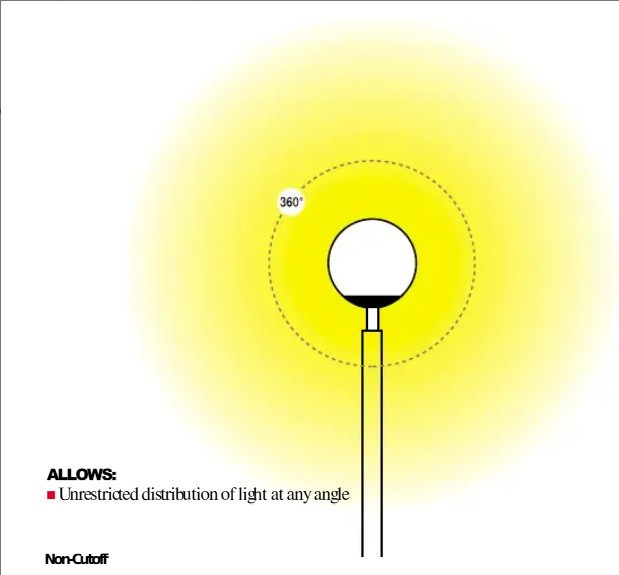
L'évolution des luminaires sans coupure vers les luminaires à coupure totale représente une avancée significative en matière d'ingénierie de l'éclairage et de cadre réglementaire, visant à atténuer les impacts négatifs de l'éclairage extérieur. Cette tendance souligne l'importance croissante de la responsabilité environnementale et de l'amélioration de la qualité visuelle dans la conception d'éclairage moderne. La lumière non restreinte (caractéristique des luminaires sans coupure) entraîne des problèmes tels que l'éblouissement, les fuites de lumière sur les propriétés adjacentes et une pollution lumineuse généralisée. 9. À l'inverse, des classifications de coupure plus strictes, comme la coupure totale, sont conçues pour répondre à ces problèmes, dans le but de « réduire la pollution lumineuse », « minimiser la lueur du ciel », « réduire l'éblouissement », « améliorer le confort visuel » et « augmenter l'efficacité énergétique ». 5Cette évolution de la classification est une réponse directe de l'industrie et des organismes de réglementation (tels que l'International Dark-Sky Association et l'IES RP-33) à la reconnaissance de l'importance de la pollution lumineuse et de l'éblouissement, qui a incité à établir des normes plus strictes pour promouvoir des pratiques d'éclairage plus responsables et durables. Elle indique que la conception de l'éclairage est passée d'une simple fourniture d'éclairage à un éclairage de « haute qualité » prenant en compte ses impacts environnementaux et humains plus larges.
Il est à noter que le système de classification traditionnel est remplacé par le système de notation BUG (Rétroéclairage-Éclairage vers le haut-Éblouissement). 3Cette transition marque une évolution vers une approche plus détaillée, plus complète et plus concrète de l'évaluation des performances d'éclairage, reconnaissant que l'éclairage vers le haut n'est qu'une composante de la pollution lumineuse et des intrusions. Le système de coupure traditionnel se concentre principalement sur l'émission de lumière à des angles supérieurs à 80° et 90° (éclairage vers le haut). Cependant, la classification BUG divise la distribution lumineuse sphérique en trois zones distinctes : « vers le haut », « avant » et « arrière », quantifiant la quantité de lumière dans chaque zone. 3Cela signifie qu'il évalue non seulement l'éclairage vers le haut, mais aussi la diffusion de lumière vers l'arrière (contre-jour, source d'intrusion) et l'éblouissement (lumière émise vers l'avant à des angles élevés et potentiellement inconfortable). Cette évolution illustre que le contrôle de l'éclairage vers le haut, bien qu'important, ne suffit pas à obtenir un éclairage extérieur véritablement complet et responsable. Le contre-jour peut entraîner une intrusion lumineuse importante sur les propriétés voisines, et l'éblouissement affecte directement le confort visuel et la sécurité. La classification BUG offre aux concepteurs et aux régulateurs un cadre plus complet et plus nuancé pour traiter toutes les principales formes de pollution et de perturbations lumineuses. Cela permet une sélection et une conception plus précises des luminaires, ce qui conduit à une meilleure qualité d'éclairage globale, une sécurité renforcée et une meilleure gestion environnementale grâce au passage d'un simple système de réussite/échec à une évaluation graduée et multidimensionnelle.
Tableau 1 : Comparaison des caractéristiques de classification des appareils de coupure
|
Type de classification |
Limite de candela à 90° (pour 1 000 lumens de lampe nue) |
Limite de candela à 80° (pour 1000 lumens de lampe nue) |
Caractéristiques principales / Contrôle de l'éclairage vers le haut |
Impacts pertinents |
|
Coupure complète |
0 1 |
Ne dépassant pas 100 (10%) 1 |
Zéro éclairage vers le haut |
Excellente conformité au ciel sombre, éblouissement minimal, pollution lumineuse minimale |
|
Couper |
Ne dépassant pas 25 (2,5%) 2 |
Ne dépassant pas 100 (10%) 2 |
Très peu de lumière vers le haut |
Bon contrôle de l'éblouissement, réduction de la lueur du ciel |
|
Semi-coupure |
Ne dépassant pas 50 (5%) 2 |
Ne dépassant pas 200 (20%) 2 |
Éclairage modéré vers le haut |
Risque d'éblouissement et d'intrusion lumineuse |
|
Non-coupure |
Sans restriction 2 |
Sans restriction 2 |
Aucune restriction d'éclairage vers le haut |
Risque élevé de pollution lumineuse et d'éblouissement |
3. Répartition des ailes de chauve-souris
La distribution en aile de chauve-souris représente une stratégie de conception optique unique visant à optimiser la qualité et l'uniformité de la lumière dans la zone éclairée. Contrairement aux classifications de coupure qui contrôlent l'éclairage vers le haut ou aux types IESNA qui définissent la forme générale de la lumière sur les surfaces, la distribution en aile de chauve-souris se concentre sur l'uniformité de l'éclairage.
3.1. Définition et profil unique
La distribution Batwing se caractérise par sa capacité à produire une lumière exceptionnellement uniforme sur une large plage d'angles de faisceau. 12. Son nom « aile de chauve-souris » dérive de la forme unique du profil d'intensité lumineuse qui ressemble aux ailes d'une chauve-souris lorsqu'il est tracé sur un graphique polaire, montrant deux pics d'intensité de chaque côté du nadir 12.
Cette distribution unique est généralement obtenue grâce à l'intégration de diffuseurs spécialement conçus ou d'éléments optiques avancés au sein du luminaire. Ces composants optiques décomposent la lumière émise par les sources LED en une série de petits faisceaux régulièrement espacés. Ce procédé de diffusion sophistiqué transforme la distribution « point chaud » plus courante (où la lumière est plus intense au centre et s'estompe rapidement vers les bords) en un flux lumineux nettement plus uniforme. 12. De plus, certaines conceptions Batwing utilisent des films optiques pour obtenir une « intensité lumineuse à double angle » afin de répondre à des besoins d'éclairage spécifiques. 13.
3.2. Avantages et applications
La distribution Batwing présente plusieurs avantages significatifs par rapport aux modèles lumineux traditionnels :
-
Rendement lumineux plus uniforme : il assure la cohérence des niveaux d'éclairage sur toute la plage d'angles de faisceau, minimisant les changements de luminosité et réduisant l'apparition de points sombres 12.
-
Points chauds réduits : en éliminant les zones concentrées de lumière, la distribution en ailes de chauve-souris atténue l'inconfort visuel et crée un environnement d'éclairage plus esthétique 12.
-
Confort visuel amélioré et environnement sans éblouissement : la répartition uniforme de la lumière réduit considérablement les contrastes forts et l'éblouissement direct, offrant aux utilisateurs une expérience visuelle plus confortable et ergonomique 12.
-
Productivité et humeur accrues : des études montrent que des environnements d'éclairage confortables, sans éblouissement et uniformes peuvent influencer positivement la productivité des utilisateurs et le bien-être général dans divers environnements tels que les bureaux, les espaces de vente au détail, les salles de classe et les bibliothèques. 12.
La distribution Batwing est un excellent choix pour une large gamme d'applications nécessitant des conditions uniformes et sans éblouissement :
-
Espaces commerciaux et industriels : les bureaux, les environnements de vente au détail, les salles de classe et les bibliothèques bénéficient d'un éclairage sans ombre ni point chaud, améliorant la concentration et réduisant la fatigue oculaire 12.
-
Éclairage résidentiel : Il contribue à créer une atmosphère plus confortable et chaleureuse dans les maisons.
-
Éclairage indirect : Particulièrement efficace avec des luminaires indirects suspendus, la lumière est dirigée vers le plafond pour éclairer indirectement l'espace. Cela crée un faisceau lumineux réfléchi large et uniforme, améliorant l'uniformité et réduisant l'éblouissement direct. 12.
La distribution Batwing est une caractéristique de conception optique qui peut être intégrée aux luminaires plutôt qu'un système de classification indépendant comme les classifications à coupure ou IESNA. Elle prend en compte la qualité et l'uniformité de la lumière dans la zone éclairée, complétant ainsi des systèmes de classification plus larges. Cette distinction est cruciale : la distribution Batwing ne remplace pas les classifications IESNA ou à coupure, mais constitue une solution d'ingénierie optique sophistiquée qui peut être intégrée aux luminaires répondant à des exigences spécifiques de coupure et IESNA. Par exemple, un luminaire à coupure complète conçu pour un parking (par exemple, IESNA Type V) peut utiliser des éléments optiques Batwing pour assurer un faisceau lumineux circulaire et uniforme sur toute la zone, sans points chauds gênants. Cela souligne qu'une conception d'éclairage efficace implique de multiples considérations qui se chevauchent : le contrôle de la lumière diffuse (coupure), la mise en forme de la zone éclairée (IESNA) et l'optimisation de la qualité lumineuse dans cette zone (batwing).
Le développement et l'adoption de la distribution en aile de chauve-souris reflètent une philosophie de conception qui a transcendé la simple quantification de l'éclairage (par exemple, l'obtention d'un certain niveau d'éclairement), privilégiant les aspects qualitatifs de l'éclairage, tels que le confort visuel et l'expérience utilisateur globale. Cela marque une maturation de la conception d'éclairage, où les facteurs humains sont de plus en plus intégrés aux spécifications techniques. La conception d'éclairage traditionnelle se concentrait principalement sur l'obtention de niveaux d'éclairement minimum. Cependant, les « points chauds » et l'« éblouissement » sont reconnus comme des problèmes entraînant « inconfort et fatigue », « fatigue visuelle » et créant des environnements « peu accueillants ». Les avantages de la distribution en aile de chauve-souris (uniformité, réduction de l'éblouissement, productivité accrue) remédient directement à ces lacunes qualitatives. 12Cela témoigne d'une évolution des priorités en matière de conception d'éclairage. Si le respect des niveaux d'éclairage quantitatifs demeure important, on prend de plus en plus conscience que la qualité de la distribution lumineuse – c'est-à-dire la régularité et le confort de la lumière – est tout aussi essentielle au bien-être, à la performance et à la satisfaction globale dans les espaces éclairés. Il s'agit d'une approche plus globale et centrée sur l'humain en matière de conception d'éclairage.
4. Normes nord-américaines d'éclairage public : classifications IESNA
L'Illuminating Engineering Society of North America (IESNA) a développé un système de classification fondamental qui décrit la répartition de la lumière sur les surfaces horizontales, un élément essentiel pour la conception des routes, des parkings et autres espaces extérieurs en Amérique du Nord. Ce système fournit un langage normalisé pour décrire les performances des luminaires.
4.1. Aperçu du système de classification IESNA
Le système de classification IESNA est principalement basé sur la forme et l'étendue de la zone d'éclairage produite par le luminaire 8Il fournit des conseils essentiels pour la conception et l'installation de divers systèmes d'éclairage extérieur, notamment les routes, les trottoirs et les parkings. 8La classification détermine la distribution lumineuse en mesurant l'endroit où la lumière tombe le plus sur une grille normalisée, en mettant l'accent sur les points d'intensité lumineuse maximale (50% candela). Le système prend en compte la distribution lumineuse latérale (transversale) et verticale (selon la direction de la route). 8.
La norme complète pour l'éclairage des routes et des parkings en Amérique du Nord est l'ANSI/IES RP-8 (Pratiques recommandées pour l'éclairage des routes et des parkings). Ce document compile de nombreuses normes indépendantes antérieures de l'IES et fournit des conseils détaillés sur la conception, la maintenance, l'efficacité énergétique, l'impact environnemental et la sécurité pour diverses applications routières et piétonnes. 11.
4.2. Types de distribution lumineuse latérale (types I, II, III, IV, V, VS)
Ces classifications définissent la manière dont la lumière est distribuée latéralement le long d'une route ou d'une zone d'éclairage, caractérisée par le point où le luminaire atteint 50% de son intensité lumineuse 8.
-
Type I :
-
Caractéristiques : Produit un faisceau lumineux elliptique étroit, symétrique ou asymétrique, avec un angle de faisceau principal généralement d'environ 15 degrés. La trajectoire en candelas du 50% se situe entre une hauteur d'installation (MH) côté maison et une hauteur d'installation côté rue. 8.
-
Applications : Convient particulièrement aux zones étroites et allongées telles que les trottoirs, les allées étroites, l'éclairage des limites et les routes à voie unique 8.
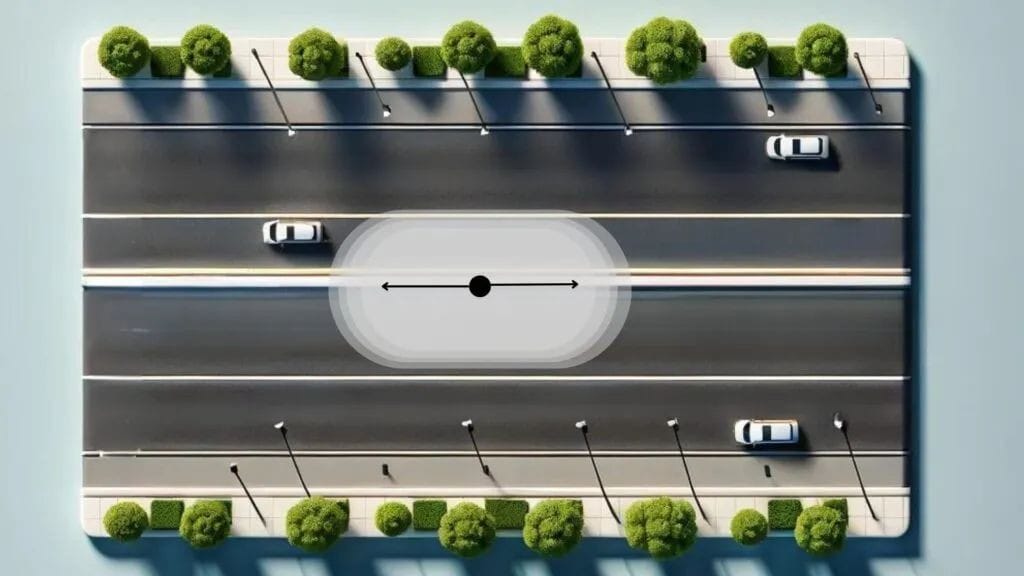
-
Type II :
-
Caractéristiques : Présente un motif asymétrique étroit avec une largeur latérale préférée de 25 degrés. La trajectoire en candela du 50% se situe entre une hauteur d'installation côté rue et 1,75 fois cette hauteur. 8Ce type convient généralement aux luminaires situés du côté proche ou à proximité de routes relativement étroites où la largeur ne dépasse pas 1,75 fois la hauteur d'installation prévue. 9.
-
Applications : Convient aux routes à 1 ou 2 voies, aux grands couloirs, aux autoroutes, aux larges trottoirs, aux petites rues secondaires, aux pistes de jogging et aux pistes cyclables 8.
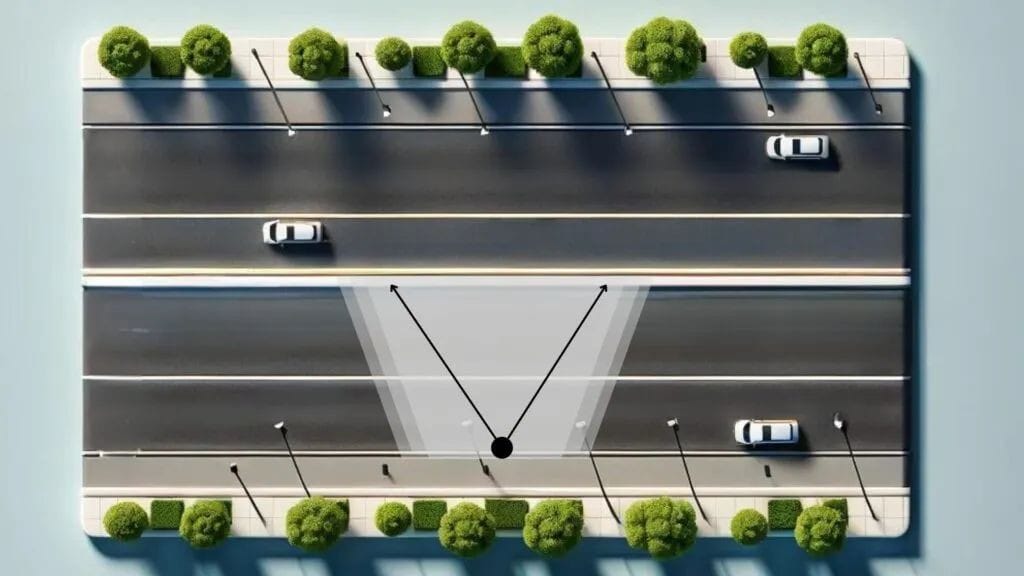
-
Type III :
-
Caractéristiques : Offre un large faisceau asymétrique, idéalement d'une largeur latérale de 40 degrés, conçu pour projeter la lumière vers l'extérieur et sur les côtés. La trajectoire en candela du 50% se situe entre 1,75 et 2,75 fois la hauteur d'installation. 8Ce type est généralement monté sur le côté de la zone à éclairer, où la largeur de la zone éclairée doit normalement être inférieure à 2,75 fois la hauteur du poteau 16.
-
Applications : Souvent utilisé dans les grands couloirs, les autoroutes, les parkings et les grandes zones ouvertes nécessitant une couverture plus large 8.
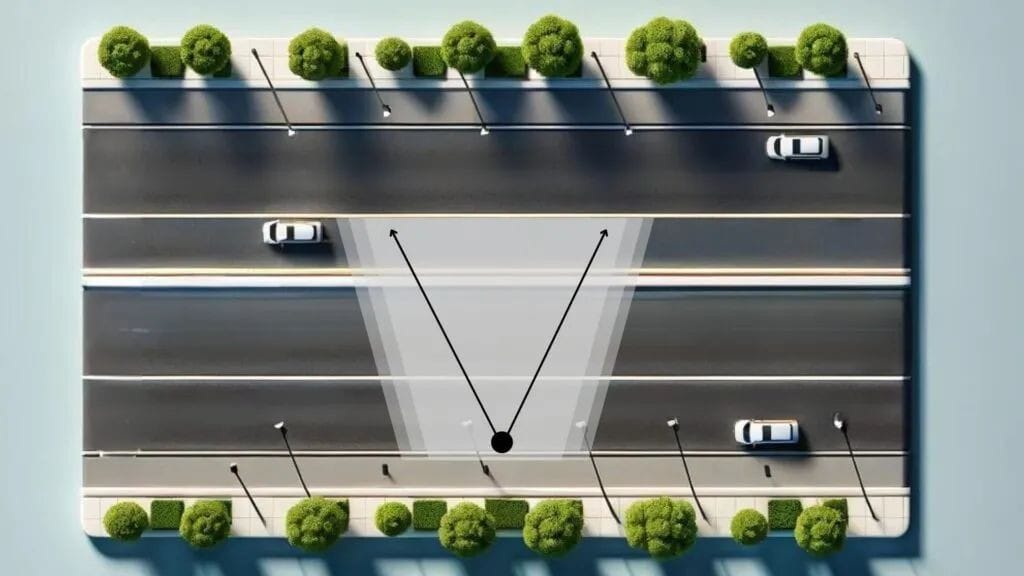
-
Type IV :
-
Caractéristiques : Présente une projection asymétrique vers l'avant, de préférence avec une largeur latérale de 60 degrés, offrant un éclairage puissant et uniforme sur une plage de 90 à 270 degrés. La trajectoire candela du 50% se situe entre 2,75 et 3,75 fois la hauteur d'installation. 8Il émet un motif lumineux elliptique, dirigeant davantage vers l'avant avec une largeur plus étroite que le type III, ce qui le rend très efficace pour contrôler le déversement de lumière 8Il est conçu pour être monté sur les côtés des routes larges, où la largeur ne dépasse pas 3,7 fois la hauteur d'installation 9.
-
Applications : Idéal pour les applications périphériques nécessitant un montage sur des murs ou des poteaux, comme les parkings, les places et les extérieurs de bâtiments, où la lumière doit être principalement dirigée vers l'avant et où un contrôle strict du déversement vers l'arrière est nécessaire 8Il émet de la lumière selon un motif semi-circulaire 21.

-
Type V :
-
Caractéristiques : Produit un motif lumineux circulaire complètement symétrique avec des intensités égales à tous les angles latéraux 4La trajectoire de la candela 50% est circulairement symétrique autour du luminaire 8.
-
Applications : Idéal pour éclairer de grandes zones ouvertes à partir d'un point de montage central, comme les parkings, les intersections, les parcs et les zones de travail ou de tâches générales où la lumière doit être projetée uniformément dans toutes les directions 4.
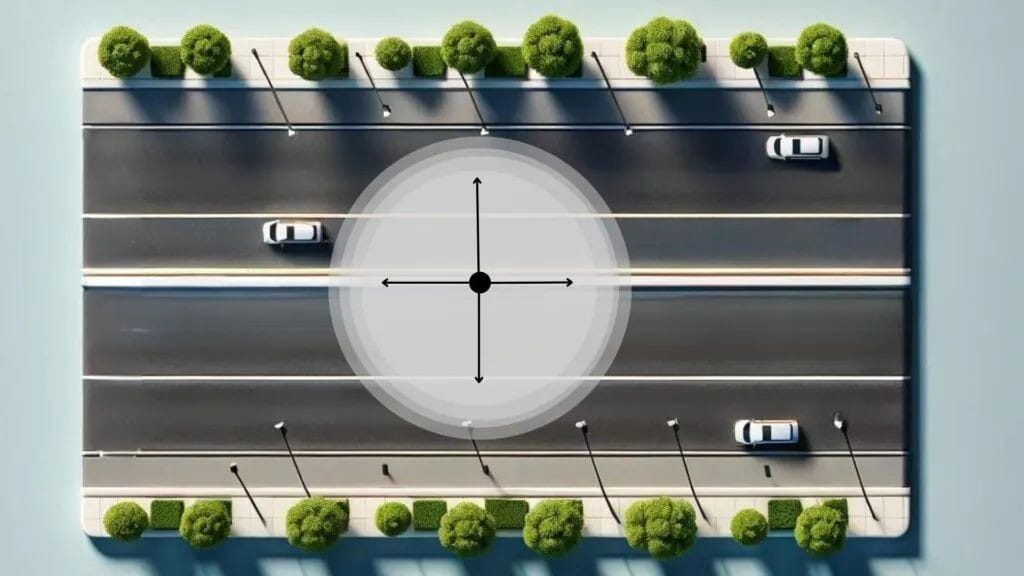
-
Type VS :
-
Caractéristiques : Similaire au type V mais produit un motif lumineux carré symétrique avec des intensités constantes à tous les angles latéraux 4.
-
Applications : Convient aux grandes surfaces nécessitant un éclairage carré uniforme, comme les parkings et les places publiques 9.
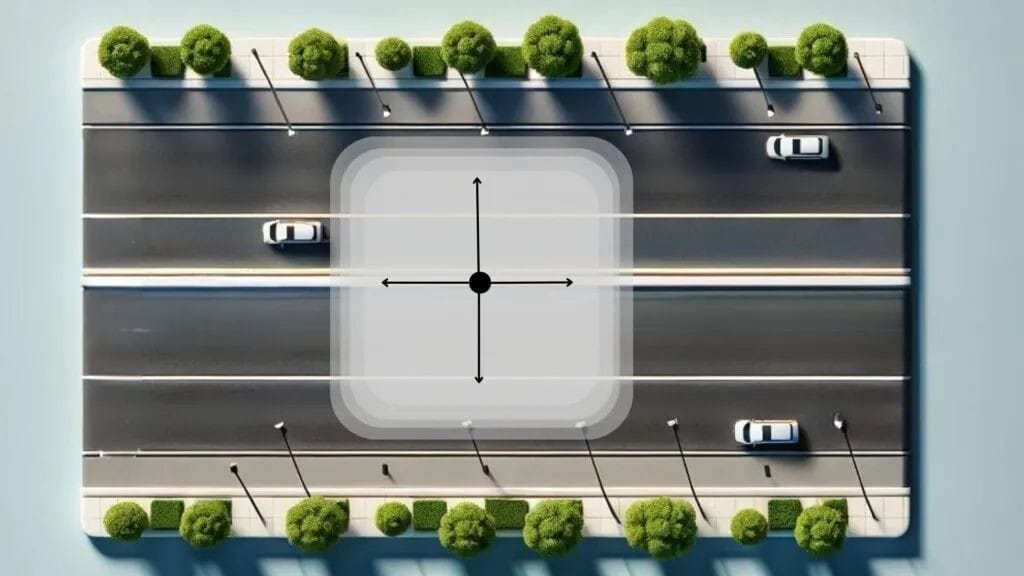
Tableau 2 : Types de distribution lumineuse latérale IESNA (IV/VS)
|
Type IESNA |
Plage de points Candela à mi-hauteur (en MH, côté rue/côté maison) |
Largeur latérale préférée (degrés, le cas échéant) |
Schéma général de distribution de la lumière |
Principales applications |
|
Type I |
1 MH côté maison à 1 MH côté rue 8 |
Environ 15 15 |
Étroit symétrique ou asymétrique |
Trottoirs, sentiers étroits, routes à voie unique |
|
Type II |
1 MH côté rue à 1,75 MH 8 |
25 21 |
Étroit asymétrique |
Routes à 1 ou 2 voies, trottoirs larges, pistes cyclables |
|
Type III |
1,75 MH à 2,75 MH 8 |
40 16 |
Large asymétrique |
Grands corridors, autoroutes, parkings |
|
Type IV |
2,75 MH à 3,75 MH 8 |
60 9 |
Lancer asymétrique vers l'avant |
Applications murales, périphéries de parkings, places |
|
Type V |
Symétrique circulaire autour du luminaire 8 |
Aucun angle spécifique, 360° symétrique 21 |
Circulaire symétrique |
Stationnements, intersections, grands espaces ouverts |
|
Type VS |
Essentiellement le même sur tous les angles latéraux 14 |
Aucun angle spécifique, 360° symétrique 4 |
Carré symétrique |
Grandes places, parkings |
4.3. Types de distribution lumineuse verticale (très courte, courte, moyenne, longue, très longue)
Ces classifications définissent la manière dont la lumière est distribuée verticalement le long de la route en fonction de la position du point de candela maximal 8Ils sont essentiels pour déterminer l’espacement approprié des poteaux et assurer un éclairage uniforme le long des routes.
-
Très court (VS) : le point candela maximal se situe entre 0 et 1,0 fois la hauteur d'installation le long de la route 8L'espacement recommandé entre les poteaux est d'environ 1 fois la hauteur d'installation 14.
-
Court (S) : Le point candela maximal se situe entre 1,0 et 2,25 fois la hauteur d'installation le long de la route 8Les luminaires classés « S » conviennent généralement aux situations où l’espacement des poteaux est inférieur à 2,25 fois la hauteur d’installation. 8.
-
Moyen (M) : Le point candela maximal se situe entre 2,25 et 3,75 fois la hauteur d'installation 8Ce type convient aux situations où l'espacement des poteaux est compris entre 2,25 et 3,75 fois la hauteur d'installation 8.
-
Long (L) : Le point candela maximal se situe entre 3,75 et 6,0 fois la hauteur d'installation 8Les luminaires de classification « L » conviennent à un espacement de poteau plus important, en particulier 3,75 à 6,0 fois la hauteur d'installation 8.
-
Très long (VL) : le point candela maximal tombe au-delà de 6,0 fois la hauteur d'installation 8.
Tableau 3 : Types de distribution lumineuse verticale IESNA (VS, S, M, L, VL)
|
Type vertical IESNA |
Plage maximale de points Candela (le long de la route en direction de MH) |
Espacement recommandé des pôles (MH) |
Principales applications/implications |
|
Très court (VS) |
0 – 1.0 8 |
1 14 |
Espacement très faible des pôles |
|
Shorts) |
1.0 – 2.25 8 |
1.0 – 2.25 14 |
Espacement des pôles plus petit |
|
Moyen (M) |
2.25 – 3.75 8 |
2.25 – 3.75 14 |
Espacement moyen des pôles |
|
Long (L) |
3.75 – 6.0 8 |
3.75 – 6.0 14 |
Espacement des pôles plus grand |
|
Très long (VL) |
> 6.0 8 |
> 6.0 |
Très grand espacement des pôles |
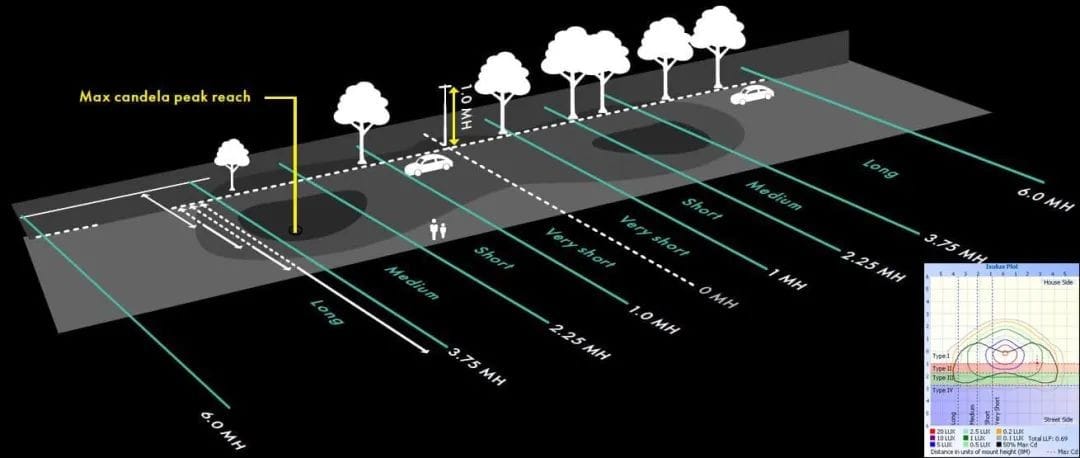
Bien que les classifications IESNA soient fondamentales, elles servent davantage de lignes directrices que de règles strictes. Leur application efficace nécessite la prise en compte de nombreuses variables spécifiques au site, soulignant le rôle crucial des outils de conception d'éclairage avancés et du jugement d'experts pour obtenir un éclairage optimal. Plusieurs ressources précisent explicitement que les classifications IESNA sont des « lignes directrices » ou des « règles non fixes » et sont influencées par des facteurs tels que la hauteur de montage des luminaires, l'angle d'inclinaison, la longueur des bras et la distance entre les luminaires et le trottoir, ainsi que la disposition des luminaires et l'état de la voirie. 8Les documents soulignent également l’importance des « données photométriques » et de la « modélisation » dans l’optimisation de la distribution lumineuse. 15La distribution lumineuse théorique définie par les types IESNA peut varier considérablement en fonction des paramètres d'installation. Par exemple, une hauteur de montage ou un angle d'inclinaison incorrects peuvent entraîner une uniformité insuffisante, un éblouissement excessif ou une distribution lumineuse inefficace, même avec le type IESNA « correct ». Cette complexité exige une analyse photométrique et une modélisation détaillées, ce qui montre qu'une conception d'éclairage efficace est un processus itératif et complexe. Il ne s'agit pas simplement de sélectionner un type de luminaire dans un catalogue. Les concepteurs doivent intégrer les connaissances théoriques (normes IESNA) aux conditions pratiques du site, en validant leurs choix grâce à des outils de modélisation avancés. Cela souligne l'importance des experts en éclairage pour maîtriser ces complexités et fournir des solutions d'éclairage optimisées et performantes.
Le système IESNA offre un cadre solide pour optimiser la couverture lumineuse et l'espacement des poteaux grâce à sa classification complète de la distribution lumineuse latérale et verticale. Cette double classification contribue directement à améliorer l'efficacité énergétique et la sécurité des projets d'éclairage routier. L'IESNA classe la lumière selon sa distribution « latérale » (traversant la route, en fonction de la largeur et de la couverture de la route) et « verticale » (le long de la route, en fonction de l'espacement des poteaux). 8Les types latéraux (IV/VS) correspondent à la largeur des routes (par exemple, type I pour les voies simples, type II pour les voies doubles, type III pour les autoroutes, type V pour l'éclairage de grandes surfaces). Les types verticaux (S, M, L) sont directement liés à l'espacement recommandé des poteaux et à la hauteur des poteaux. 8En définissant précisément la propagation de la lumière latéralement et verticalement le long de la route, l'IESNA permet aux concepteurs de choisir des luminaires qui minimisent le chevauchement lumineux (gaspillage d'énergie) et éliminent les zones d'ombre (impact sur la sécurité et le confort visuel). Par exemple, opter pour une distribution verticale « longue » permet d'espacer les poteaux plus largement, réduisant ainsi considérablement le nombre de poteaux et de luminaires nécessaires pour un segment donné. Cela a un impact direct sur les coûts d'installation initiaux et la consommation d'énergie à long terme. 8À l'inverse, une mauvaise appréciation de la distribution verticale peut entraîner un suréclairage ou une couverture insuffisante entre les poteaux. L'intégration des classifications latérales et verticales permet une conception d'éclairage hautement optimisée, à la fois fonctionnelle et économe en ressources. Cette optimisation est essentielle pour atteindre les objectifs définis dans des normes telles que la norme ANSI/IES RP-8-22, qui visent notamment à « minimiser la consommation d'énergie », « améliorer la qualité de la vision du conducteur » et « fournir un éclairage de haute qualité et augmenter le contraste de visibilité des dangers ». 18Il s’agit d’une approche systématique et scientifique visant à équilibrer les besoins d’éclairage avec la faisabilité économique, la sécurité et l’impact environnemental.
5. Analyse comparative et considérations de conception
En Amérique du Nord, la conception d'un éclairage extérieur efficace reflète l'interaction complexe de divers systèmes de classification et caractéristiques optiques. Comprendre l'interaction entre les luminaires à coupure, les luminaires sans coupure, les distributions en aile de chauve-souris et les classifications IESNA est essentiel pour développer des solutions d'éclairage optimales, conformes et durables.
5.1. Interaction entre les classifications de seuil et les types IESNA
Les classifications de coupure (coupure complète, coupure, semi-coupure, non-coupure) contrôlent principalement la quantité de lumière émise au-dessus du plan horizontal, servant de mécanismes clés pour contrôler la pollution lumineuse et l'éblouissement 1En revanche, les types IESNA (IV/VS) décrivent la forme et la distribution de la lumière au sol, déterminant l'efficacité de l'éclairage dans des zones telles que les routes ou les parkings. 8.
Dans l'éclairage public nord-américain contemporain, l'utilisation de luminaires à coupure totale est une priorité absolue. Cette préférence s'explique par des initiatives rigoureuses en matière de ciel étoilé, des objectifs de protection de l'environnement et la volonté de minimiser les intrusions lumineuses et l'éblouissement. 5Ces luminaires à coupure totale sont ensuite conçus avec des distributions latérales et verticales spécifiques IESNA (par exemple, les luminaires à coupure totale de type III à distribution moyenne). La coupure totale garantit le respect de l'environnement en empêchant la lumière de se propager vers le haut, tandis que le type IESNA assure une orientation et une distribution fonctionnelles de la lumière vers la zone ciblée (par exemple, une autoroute à plusieurs voies ou un grand parking). Ces deux systèmes fonctionnent en synergie : la coupure cible les zones où la lumière ne doit pas aller, tandis que l'IESNA cible les zones où la lumière doit aller et comment elle doit être distribuée.
5.2. Intégration de la distribution des chauves-souris aux classifications IESNA
La distribution en ailes de chauve-souris n'est ni une classification IESNA ni une classification de seuil. Il s'agit plutôt d'une caractéristique optique spécialisée visant à améliorer la qualité et l'uniformité de la lumière dans la zone éclairée. 12Son objectif principal est d’éliminer les points chauds et de fournir un environnement d’éclairage confortable et sans éblouissement.
Les éléments optiques Batwing s'intègrent parfaitement aux luminaires présentant diverses distributions IESNA, notamment ceux conçus pour une couverture étendue. Par exemple, les luminaires créant un motif circulaire symétrique (IESNA Type V) peuvent être équipés d'éléments optiques Batwing. 9. Cette combinaison crée un motif lumineux circulaire qui est non seulement symétrique mais également exceptionnellement uniforme sans points chauds gênants, ce qui le rend parfaitement adapté aux zones nécessitant un éclairage cohérent telles que les grandes places, les intersections centrales ou les espaces industriels ouverts. 9. De même, on peut également le trouver dans les distributions de type III 23. Ceci illustre comment le batwing peut servir d’amélioration qualitative dans le cadre quantitatif de l’IESNA.
5.3. Considérations globales pour les projets d'éclairage public en Amérique du Nord
Le choix des luminaires pour les projets d'éclairage public en Amérique du Nord est un problème d'optimisation multidimensionnel qui nécessite une approche globale équilibrant la conformité réglementaire (coupure/BUG), les exigences fonctionnelles (latérales/verticales IESNA) et la qualité de l'éclairage (batwing, contrôle de l'éblouissement), afin d'optimiser la sécurité, l'efficacité et la gestion environnementale. Il s'agit rarement d'un choix isolé.
-
Efficacité énergétique : Choisir stratégiquement des luminaires avec des classifications de coupure appropriées (notamment à coupure totale) et des types IESNA optimisés contribue directement aux économies d'énergie. En dirigeant précisément la lumière vers les zones souhaitées et en minimisant le gaspillage (éclairage direct, rétroéclairage, débordement), la consommation énergétique globale peut être réduite. 6L'adoption généralisée de la technologie LED améliore encore ces rendements grâce à sa flexibilité de conception inhérente et à son rendement lumineux/watt plus élevé. 9.
-
Confort visuel et sécurité : Réduire l'éblouissement et garantir une grande uniformité d'éclairage sont essentiels pour le confort visuel et la sécurité. Des luminaires à coupure d'intensité (cutoff) appropriés peuvent réduire l'éblouissement gênant pour les conducteurs et les piétons, tandis que des types IESNA appropriés (potentiellement renforcés par des éléments optiques en forme d'aile de chauve-souris) assurent des niveaux d'éclairage uniformes, réduisant les ombres et améliorant la visibilité des dangers. 8Cela est directement lié à la réduction des taux d'accidents de la route la nuit et à l'augmentation de la sécurité des piétons. 18.
-
Initiatives pour un ciel étoilé et impact environnemental : adhérer aux principes de coupure totale ainsi qu'aux directives d'organisations comme DarkSky International 7 et les pratiques recommandées de l'IES (telles que la pratique recommandée RP-33 pour l'éclairage environnemental extérieur) 5 est crucial pour atténuer la lueur du ciel, protéger les paysages nocturnes naturels et préserver les écosystèmes nocturnes. Cela reflète une prise de conscience environnementale croissante dans la conception de l'éclairage.
-
Conformité réglementaire : les réglementations locales, les codes municipaux et les lois des États en Amérique du Nord imposent souvent des classifications de coupure spécifiques (par exemple, coupure complète) et recommandent ou exigent généralement que diverses applications d'éclairage extérieur adhèrent aux types IESNA. 5La conformité n’est pas seulement une exigence légale mais aussi un engagement en faveur d’un développement urbain responsable.
-
Avantages économiques : Outre les avantages environnementaux et sécuritaires, une conception d'éclairage optimisée, conforme aux normes IESNA et aux exigences de coupure, peut engendrer des avantages économiques significatifs. Cela inclut notamment la réduction des coûts d'installation initiaux (par exemple, en optimisant l'espacement des poteaux avec les modèles verticaux IESNA). 8) ainsi que des coûts d'exploitation à long terme réduits grâce aux économies d'énergie 18De plus, des zones bien éclairées peuvent améliorer la perception du public et potentiellement attirer davantage de piétons dans les quartiers commerciaux, stimulant ainsi l'activité économique. 18.
Dans les applications pratiques, les luminaires doivent répondre à de multiples exigences : par exemple, ils doivent être « à coupure complète » pour se conformer aux réglementations sur le ciel étoilé et minimiser la pollution lumineuse. 6; ils doivent posséder le type latéral IESNA approprié (par exemple, type II ou type III) pour éclairer efficacement les routes de largeurs spécifiques 8; ils doivent avoir le type vertical IESNA approprié (par exemple, moyen ou long) pour un espacement optimal des poteaux le long de la route, garantissant l'uniformité et la rentabilité 8; et ils pourraient avoir besoin d'intégrer des éléments optiques en forme d'aile de chauve-souris pour garantir que la lumière de surface est répartie uniformément sans éblouissement, améliorant ainsi le confort visuel des utilisateurs. 12. De plus, toutes les conceptions doivent être conformes aux codes municipaux locaux 5Cette exigence multidimensionnelle indique que les concepteurs lumière ne peuvent pas se contenter d'isoler un seul type IESNA. Ils doivent prendre en compte la valeur de coupure des luminaires, leurs éléments optiques internes (comme le Batwing) et la manière dont ces caractéristiques s'articulent pour répondre aux différents objectifs fonctionnels, environnementaux, réglementaires et esthétiques du projet. La complexité de la recherche de luminaires répondant simultanément à tous ces critères nécessite souvent des analyses photométriques détaillées et des outils de modélisation. 15Cela met en évidence le rôle essentiel de la consultation d’experts et des processus de conception complets dans l’éclairage extérieur moderne.
6. Conclusion
La conception de l'éclairage extérieur, notamment en Amérique du Nord, est un domaine complexe et nuancé, axé sur une compréhension approfondie des différents concepts de distribution lumineuse. Cet article explique les distinctions fondamentales entre les luminaires à coupure (coupure totale, coupure, semi-coupure), les luminaires sans coupure et la distribution spécialisée en aile de chauve-souris, en proposant une comparaison exhaustive avec le système de classification IESNA, qui fait autorité en matière d'éclairage routier.
Les classifications de coupure servent principalement de mécanismes importants pour contrôler la pollution lumineuse et l'éblouissement. Les luminaires à coupure totale répondent aux normes les plus strictes et les plus respectueuses de l'environnement en dirigeant toute la lumière vers le bas. En revanche, les luminaires sans coupure augmentent considérablement les intrusions lumineuses et la lueur du ciel en raison de l'absence de tels contrôles, ce qui restreint de plus en plus leur utilisation. La distribution Batwing se distingue de ces classifications plus larges car il s'agit d'une solution d'ingénierie optique visant à obtenir une uniformité et un confort visuel exceptionnels dans la zone d'éclairage, généralement en complément des types IESNA pour des applications spécifiques nécessitant un éclairage sans points chauds.
En fin de compte, la conception optimale de l'éclairage public en Amérique du Nord est une tâche complexe et exhaustive. Elle nécessite l'intégration des schémas de distribution précis et localisés spécifiés par l'IESNA, avec des exigences strictes en matière de coupure et, le cas échéant, des solutions optiques avancées comme la distribution en aile de chauve-souris. Cette approche intégrée garantit non seulement un éclairage fonctionnel, mais maximise également l'efficacité énergétique, améliore la sécurité publique et le confort visuel, et maintient les initiatives essentielles de protection du ciel étoilé. Un choix éclairé et une conception professionnelle des luminaires, conformes à ces normes et considérations intégrées, sont essentiels pour créer des environnements d'éclairage extérieur durables, conformes et de haute qualité pour les collectivités.
Comment choisir la tour d'éclairage solaire à LED avec options d'énergie hybride
Choisir la bonne tour d'éclairage solaire à LED avec options d'énergie hybride
Lors de la sélection d'une tour d'éclairage solaire avec des sources d'énergie mixtes (solaire, éolienne, diesel, réseau), tenez compte des besoins d'éclairage, de la portée, de la fonctionnalité, de la durée de fonctionnement et des conditions spécifiques du site.
Comparaison rapide (trois modèles courants pour le dépistage initial)
- Petite tour solaire — Hauteur : 6 m ; Couverture : ~750 m² ; Rendement lumineux : ~33 000 lm ; Batterie : ~9,6 kWh ; Autonomie : ~28,8 h (selon la luminosité).
- Remorque d'éclairage mobile moyenne — Hauteur : 9 m ; Couverture : ~1 500 m² ; Rendement lumineux : ~66 000 lm ; Batterie : ~14,4 kWh ; Autonomie : ~20 h.
- Grande remorque d'éclairage portable — Hauteur : 12 m ; Couverture : ~2 200 m² ; Rendement lumineux : ~198 000 lm ; Batterie : ~28,8 kWh ; Autonomie : ~20 h.
Remarque : Les durées d'exécution réelles dépendent des réglages de luminosité, de la charge, des conditions météorologiques et des conditions du site. Utilisez les données de test réelles pour une planification précise.

2. Choisissez en fonction de la couverture d'éclairage
3. Choisissez en fonction de la fonctionnalité
- Surveillance 4G : Optionnel pour la surveillance en temps réel dans les zones peuplées, les chantiers de construction et les emplacements sensibles pour améliorer la sécurité et la protection des actifs.
- Applications de sauvetage d'urgence : Optez pour des modèles avec recharge hybride et privilégiez l’unité de plus grande capacité pour maximiser l’autonomie et la luminosité en cas de catastrophe.
- Type de batterie : Les batteries au plomb-acide sont généralement choisies pour la sécurité sur les chantiers extérieurs où le lithium présente des risques d'incendie dans des environnements instables ; des options LiFePO4 sont également disponibles avec des mesures de sécurité appropriées.
- Capacité de la station de base 5G : Utile pour les régions éloignées ou à signal faible, étendant la connectivité là où c'est nécessaire.
4. Luminosité et efficacité énergétique
- Niveaux de luminosité se déclinent généralement en trois niveaux :
- 33 000 lm — adapté aux petits sites et aux zones de travail à faible densité.
- 66 000 lm — adapté aux zones de travail de taille moyenne et aux besoins de sécurité.
- 198 000 lm — pour les environnements de haute sécurité ou les opérations à grande échelle nécessitant une large visibilité.
- Conseils d'utilisation : Pour les petits sites, une luminosité plus faible est souvent suffisante ; pour les sites plus grands ou une sécurité plus élevée, une luminosité plus élevée est préférable.
- Efficacité énergétique : Privilégiez une efficacité des luminaires supérieure à 150 lm/W pour réduire les coûts d’exploitation à long terme.
5. Température de couleur et rendu
- Choix de température de couleur : 5 000–6 500 K (blanc froid) pour les zones de travail et les opérations d’urgence ; 2 700–3 000 K (blanc chaud) pour les zones de repos ou de sécurité où le confort est important.
- Rendu des couleurs (IRC) : Un IRC plus élevé (> 80) permet de distinguer les couleurs et les détails dans les environnements critiques tels que les interventions d'urgence, l'exploitation minière, la construction, le camping, les points de contrôle de sécurité, les stations de signalisation et les zones de sécurité.
- Efficacité: Les luminaires LED à haute efficacité favorisent les économies d’énergie au fil du temps.
Pour des raisons de respect de l'environnement et de performance, pensez aux tours à énergie hybride qui basculent automatiquement entre les sources solaires, éoliennes, diesel et réseau pour maintenir l'éclairage dans des conditions variables.
Comprendre les différentes tours d'éclairage solaire hybrides
Tour d'éclairage solaire uniquement
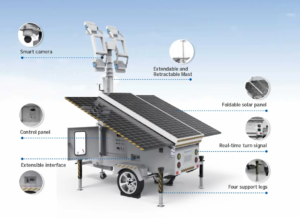
Avantages : Respectueux de l'environnement, faibles coûts d'exploitation, entretien simple.
- Caractéristiques : rotation à 360° et éclairage
- Temps de travail : jusqu'à 35 heures
Applications typiques : Régions ensoleillées, adaptées aux besoins d'éclairage temporaires ou à long terme.
Modèles représentatifs :
Tour d'éclairage solaire (mobile),
Tour d'éclairage solaire (variante 2).
Tour d'éclairage hybride éolienne et solaire
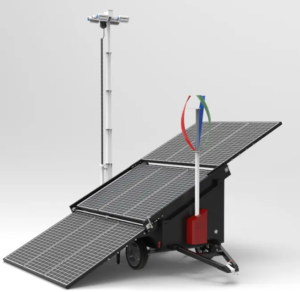
Avantages : Fournit une énergie stable dans les régions riches en vent.
- Caractéristiques : Jusqu'à 80 heures d'autonomie
- Applications typiques : zones reculées, sites dotés de ressources éoliennes abondantes, éclairage de secours après catastrophes
Modèles représentatifs :
Systèmes solaires hybrides soleil-vent et
Générateur solaire mobile Sunwind.
Tour de générateur hybride diesel et solaire
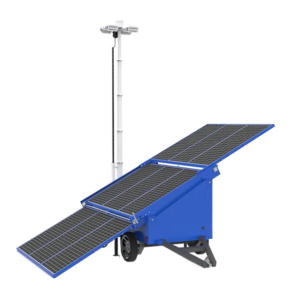
Avantages : Approvisionnement énergétique stable dans les zones sans accès au réseau.
- Caractéristiques : Jusqu'à 80 heures d'autonomie
- Applications typiques : Construction à distance, sauvetage en montagne, points logistiques d'événements majeurs
Modèle représentatif :
Véhicules hybrides solaires Sundiesel.
Tour d'éclairage alimentée par le réseau
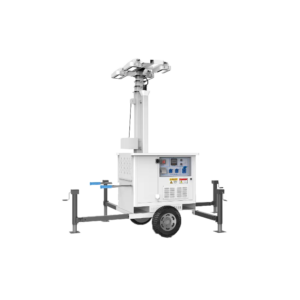
Avantages : Approvisionnement énergétique stable là où les réseaux électriques existent.
- Efficacité : 195 lm/W d'efficacité du luminaire
- Surface éclairée : 1 200 m²
- Temps de travail : 35 heures
- Applications typiques : grands chantiers de construction, emplacements d'infrastructures urbaines, lieux d'événements
Modèle représentatif :
Tour d'éclairage mobile électrique (T300, 6 m).
Tableau de sélection de référence rapide
| Modèle | Hauteur | Zone de couverture | Sortie de la lumière | Capacité de la batterie | Durée d'exécution (typique) | Options énergétiques |
|---|---|---|---|---|---|---|
| Petite tour solaire | 6 m | 750 m² | 33 000 lm | 9,6 kWh | ~28,8 h | Solaire, hybride, diesel, réseau (en option) |
| Remorque légère mobile moyenne | 9 m | 1 500 m² | 66 000 lm | 14,4 kWh | ~20 h | Solaire, hybride, diesel, réseau (en option) |
| Grande remorque légère portable | 12 m | 2 200 m² | 198 000 lm | 28,8 kWh | ~20 h | Solaire, hybride, diesel, réseau (en option) |
Autres considérations
Maintenance et entretien
- Inspection régulière des luminaires et des batteries
- Nettoyer les panneaux photovoltaïques pour maintenir les performances du système
- Assurer la fiabilité globale du système grâce à des contrôles de routine
Adaptabilité environnementale
- Indice de protection : Choisissez des luminaires avec un indice de protection élevé (par exemple, IP65) pour résister aux conditions météorologiques difficiles
Budget et coût total
- Tenez compte des coûts initiaux de l’équipement, de l’installation et de la maintenance continue pour obtenir un véritable coût total de possession.
Les tours d'éclairage solaires portables Luxman utilisent des panneaux solaires à haut rendement, des batteries au lithium longue durée et des luminaires LED haute luminosité pour garantir une performance stable et durable. Luxman propose également des modèles hybrides (par exemple, solaire + éolien, solaire + diesel) pour répondre à divers environnements et exigences.
En suivant ces directives, vous pouvez sélectionner la tour d'éclairage solaire portable Luxman qui correspond le mieux à vos besoins et garantir un éclairage fiable et des performances à long terme.
Prêt à trouver le modèle parfait pour votre site ? Contactez Luxman dès aujourd'hui pour une solution sur mesure.

